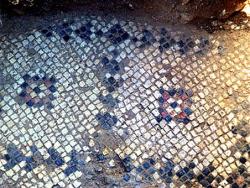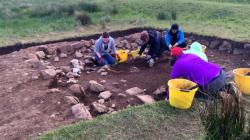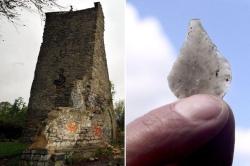INSTITUT SUPERIEUR D'ANTHROPOLOGIE
INSTITUTE OF ANTHROPOLOGY
ONLINE COURSES / COURS A DISTANCE
FALL TERM : OCTOBER 2015
REGISTER NOW
ISRAEL –  Nazareth - The University of Hartford says a team of archaeologists recently uncovered an ancient mosaic floor at a Greek Orthodox church in Nazareth, Israel. The university says the mosaic floor appears to be from one of the earliest churches in the history of Christianity. It was uncovered recently at the Church of the Annunciation by archaeologists led by Professor Richard Freund and Maha Darawsha of the University of Hartford and Shalom Yanklovitz at Israel's Haifa University. According to tradition, the angel Gabriel announced the forthcoming birth of Jesus at a spring or well that Mary was visiting to get water. It's where the Greek Orthodox put their church in the Byzantine period. The mosaic floor is believed to date to the fourth century and was uncovered with radar and other technology.
Nazareth - The University of Hartford says a team of archaeologists recently uncovered an ancient mosaic floor at a Greek Orthodox church in Nazareth, Israel. The university says the mosaic floor appears to be from one of the earliest churches in the history of Christianity. It was uncovered recently at the Church of the Annunciation by archaeologists led by Professor Richard Freund and Maha Darawsha of the University of Hartford and Shalom Yanklovitz at Israel's Haifa University. According to tradition, the angel Gabriel announced the forthcoming birth of Jesus at a spring or well that Mary was visiting to get water. It's where the Greek Orthodox put their church in the Byzantine period. The mosaic floor is believed to date to the fourth century and was uncovered with radar and other technology.
http://www.courant.com/education/hc-university-of-hartford-ancient-mosaic-0621-story.html
ROYAUME UNI – Wakefield - The history books of Wakefield may need to be rewritten following an archeological survey in Thornes Park.It was previously thought that the remains of the earth and timber castle at Lowe Hill dated back to an undocumented siege of Sandal Castle. But a new site investigation suggests it dates back to the Normans. Ian Deighton, chairman of CHaT, said: “Can you believe we have a Norman Castle at the centre of our Park that hardly anyone knows about? Most casual visitors to the park and local residents may not be aware that the partially wooded summit of Lowe Hill contains the remains of an earth and timber castle that is thought to date from the 12th century.” The survey revealed within the inner bailey of the castle at least four pit-like features. These may be rubbish pits and suggest extended occupation of the site.
http://www.wakefieldexpress.co.uk/news/discovery-of-a-norman-castle-in-the-centre-of-city-park-1-7319011
ROYAUME UNI – 
 Belfast - From the neolithic to the medieval period, a host of historical artefacts have been hiding in the Belfast hills. Perhaps the most interesting find has been the foundations of a house dating back to the 1300s. The archaeologists said it is a hugely significant find, opening another door into the past and allowing us to learn more about how people used to live. A flint scraper, used by people living more than 3,000 years ago, was also found. It would have been used to scrape animal skins, and as a sort of tool for eating food. The dig has been going on for several weeks, but at the end of next week it will all be covered up again and restored to how it was before the archaeologists dug their trowels into the previously untouched land.
Belfast - From the neolithic to the medieval period, a host of historical artefacts have been hiding in the Belfast hills. Perhaps the most interesting find has been the foundations of a house dating back to the 1300s. The archaeologists said it is a hugely significant find, opening another door into the past and allowing us to learn more about how people used to live. A flint scraper, used by people living more than 3,000 years ago, was also found. It would have been used to scrape animal skins, and as a sort of tool for eating food. The dig has been going on for several weeks, but at the end of next week it will all be covered up again and restored to how it was before the archaeologists dug their trowels into the previously untouched land.
http://www.bbc.co.uk/news/uk-northern-ireland-33230482
ROYAUME UNI –  Saffron Walden - CSI Hilary Miller was made aware of a case that police officers were called to Croudace Builders housing development in Debden Road, Saffron Walden, had discovered what appeared to be human bones after digging four feet into the earth. CSI then sent photos to Dr Lucinda Hackman from Dundee University, who explained: "The bones in the images are human in origin and include a right femur (legbone) and part of the left femur. "We are unable to tell how old the bones are, but they do appear to be lying in anatomical position which would be consistent with a previously undisturbed burial”. The archaeologist believed that the bones would at least 150 years old from the photographs alone. However, as Roman and late Iron Age artefacts have previously been found on the opposite side of Debden Road, as well as the condition of the bones, it is thought that the remains may date back to Roman times.
Saffron Walden - CSI Hilary Miller was made aware of a case that police officers were called to Croudace Builders housing development in Debden Road, Saffron Walden, had discovered what appeared to be human bones after digging four feet into the earth. CSI then sent photos to Dr Lucinda Hackman from Dundee University, who explained: "The bones in the images are human in origin and include a right femur (legbone) and part of the left femur. "We are unable to tell how old the bones are, but they do appear to be lying in anatomical position which would be consistent with a previously undisturbed burial”. The archaeologist believed that the bones would at least 150 years old from the photographs alone. However, as Roman and late Iron Age artefacts have previously been found on the opposite side of Debden Road, as well as the condition of the bones, it is thought that the remains may date back to Roman times.
http://www.essexchronicle.co.uk/Ancient-Roman-bones-discovered-housing/story-26744104-detail/story.html
ROYAUME UNI –  Cardiff - The major excavation of a Welsh hillfort could help uncover Cardiff’s prehistoric origins. From today, a team of around 200 members of the Caerau and Ely communities will spend four weeks working alongside Cardiff University archaeologists at Caerau Hillfort, one of Wales’ most significant yet least well-known heritage sites. The dig follows hugely successful excavations in 2013 and 2014, when discoveries from the Bronze Age through to the late Roman era were made. Among the finds were five large Iron Age roundhouses, a roadway, extensive assemblages of Iron Age and Roman pottery, and a decorated Iron Age glass bead. Last summer’s excavation also uncovered a wealth of Neolithic finds, including a number of flint tools and weapons dating to around 3,600 BC.
Cardiff - The major excavation of a Welsh hillfort could help uncover Cardiff’s prehistoric origins. From today, a team of around 200 members of the Caerau and Ely communities will spend four weeks working alongside Cardiff University archaeologists at Caerau Hillfort, one of Wales’ most significant yet least well-known heritage sites. The dig follows hugely successful excavations in 2013 and 2014, when discoveries from the Bronze Age through to the late Roman era were made. Among the finds were five large Iron Age roundhouses, a roadway, extensive assemblages of Iron Age and Roman pottery, and a decorated Iron Age glass bead. Last summer’s excavation also uncovered a wealth of Neolithic finds, including a number of flint tools and weapons dating to around 3,600 BC.
http://www.walesonline.co.uk/news/wales-news/we-hope-forefront-discovery-further-9496860